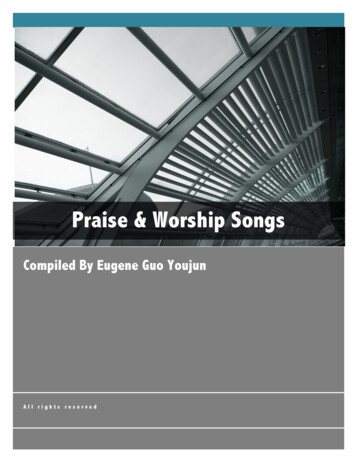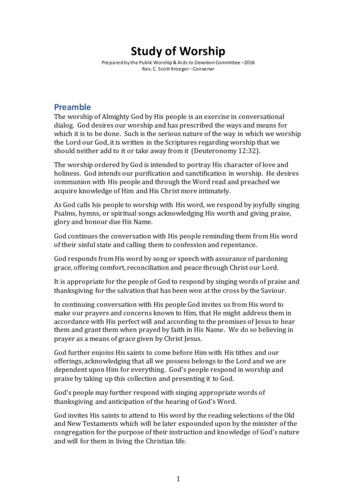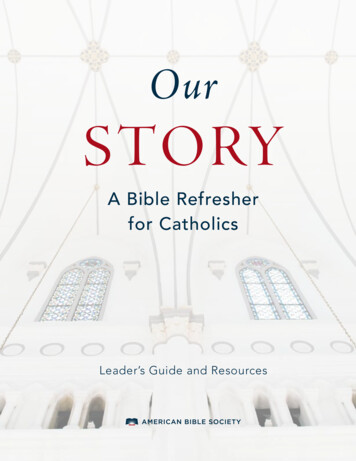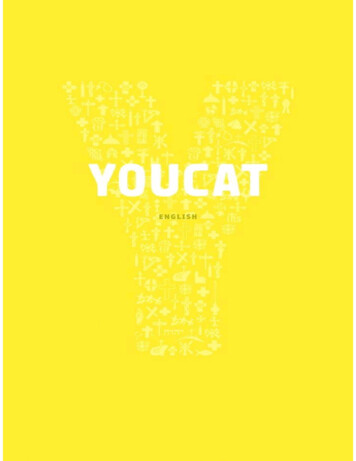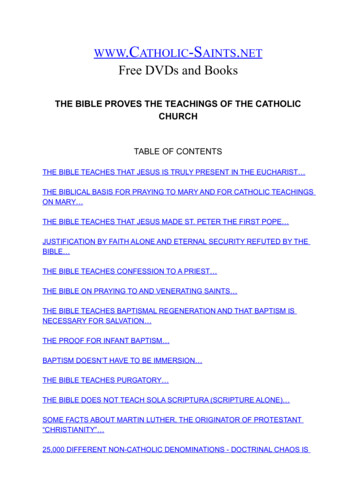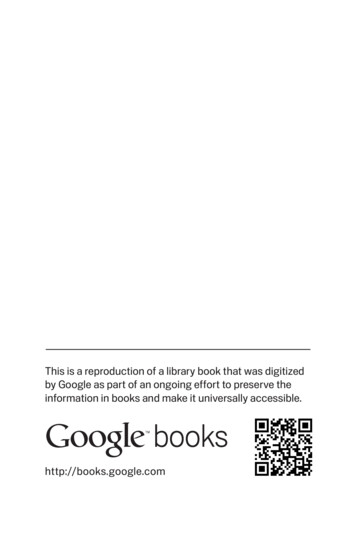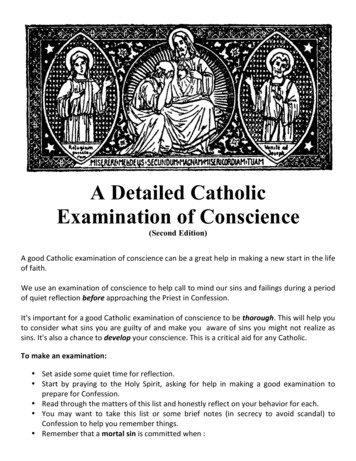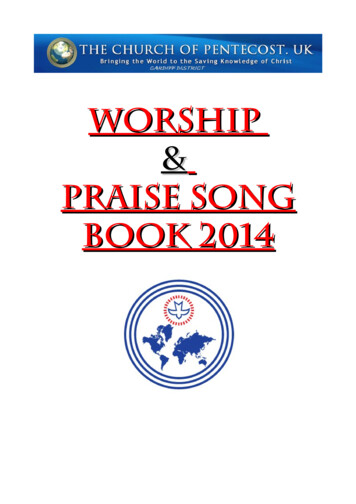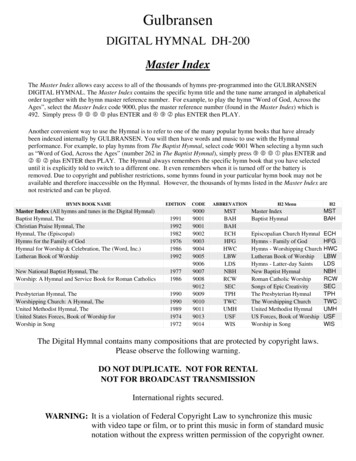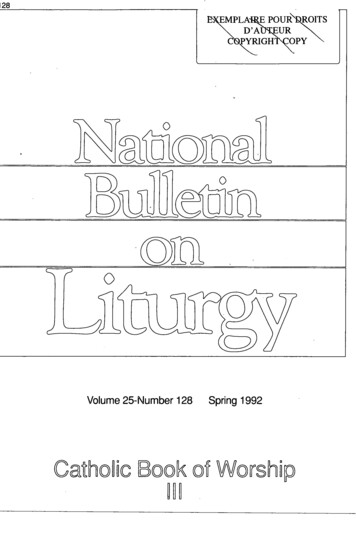
Transcription
128MPLA OURt :0ITS D'AURYRIGHOPYVolume 25-Number 128Ca ho cSpring 1992Book o Wo sh p
Notice to §ubscribersTo onform to t e practice of other eeeB publications, the dating of theNational Bulletin on Liturgy has been changed from March, June,September and December to Spring, Summer, Fall and Winter.National Bulletin on LiturgyA review published by theCanadian Conferenceof Catholic Bishops.This Bulletin is primarily pastoral in scope. It isprepared for members of parish liturgy committees, readers, musicians, singers, catechists,teachers, religious, seminarians, clergy, anddiocesan liturgical commissions, and for allwho are involved in preparing, celebrating,and improving the community's life of worshipand prayer.Editorial commentary in the Bulletin is the responsibility of the editor.EditorJ. FRANK HENDERSONEditorial Office:NATIONAL LITURGICAL OFFICE90 Parent Avenue(613) 236-9461Ottawa, Ontario K1N 7B1extension 176Business Office:NOVALISP.O. Box 990Outremont, QuebecH2V 4S7 (514) 948-1222Subscriptions:For one year, excluding 7% GST:CanadaUnited StatesIntemational1-9 copies 10 1-9 copies 12 US (air mail)10-24 9 10 10 US 25 US25 8Quantity discount for this issue:For 50 or more copies to one address,30% discount.Publisher:PUBLICATIONS SERVICECanadian Conference of Catholic Bishops90 Parent AvenueOttawa, OntarioK1N 7B1The price of a single issue is now 4.00. Individual copies and back issues must be purchased from the publisher. Customers shouldadd to the price the GST (7%) plus shippingand handling (14% on orders under 9.99 or8% on orders of 10.00 and over).National Bulletin on Liturgy, copyright Concacan Inc., 1991. No part of this Bulletinmay be reproduced in any form without theprior written permission of CCCB Publications Service.International Standard Serial Number:ISSN 0084-8425Legal deposit:National Library, Ottawa, CanadaSecond Class Mail:Registration Number 2994The text of the Bulletin is printed on recycledpaper. This reflects our concern for the environment and the conservation of our naturalresources.
National Bulletin On LiturgyVolume 25 - Number 128 - Spring 1992CatholicBook ofWorshipIIIThis issue will describe our new national hymnal, to be published in late Fall 1992. What will it contain? What principleswere considered in choosing its contents? How might it beintroduced to parish communities? How might we makebest use of the rich resources it contains?1
Table of ContentsPageIntroduction . .3The Story of CBW IIIMurray J. Kroetsch . . . . . . .4What the People of Canada SaidAbout Catholic Book of Worship IILoretta Manzara and Murray J. Kroetsch . .10Hymns in CBW IIILoretta Manzara and Murray J. Kroetsch . ,.13Service MusicMurray J. Kroetsch and Loretta Manzara. . . . . . .33How to Introduce the New HymnalLoretta Manzara . . . . . . . .37Establishing Common Repertoire in the ParishLoretta Manzara .38Meet our Music EngraverJohn Bird.39Guidelines for Music in the LiturgyJohn Hibbard.40Music Serves the Expression of Faith.44Helps for Aspiring Hymn WritersMargaret Clarkson. . . . . .45Composing Music for the AssemblyMichel Guimont .50Exploring the Rhythm of a TextDavid M. young.52An Analysis of David Young's Tune CraigleithLoretta Manzara .53The Evolution of a Hymn TextLoretta Manzara . .55Selected Readings for Musicians.63Other NotesOur Next Issue. . .32Summer Courses . . 36, 43, 442
IntroductionFall 1992 will bring a long-awaited event of great significance to the RomanCatholic Church in Canada: the publication of Catholic Book of Worship 11/(CBW III), the third edition of our national hymnal. This improved and expanded music and worship resource will serve our liturgical worship for the nextdecade or more. As liturgy today is normatively considered a musical experience, it is crucial to have a good hymnal- and to use it.In Canada we are blessed by having a national hymnal published by thechurch. Because it is national we have a sense of unity in our worship, a common repertoire, and the best resource that the national church can produce.Because it is published by the church, we appreciate that the hymnal is a liturgical book on par with the sacramentary, lectionary and other liturgical books.We know that the bishops and the rest of the church take musical worship veryseriously indeed.This issue of the Bulletin has been prepared or supervised by two personswho played key roles in the preparation of CBW III. They bring their greatexpertise and here introduce the new hymnal to the rest of the church. The Reverend Murray Kroetsch, while Director of the National LiturgicalOffice also chaired the hymnal revision committee. Now a pastor in theHamilton diocese, he continues to bring this project to completion. Sister Loretta Manzara, CSJ was secretary and full-time staff person for thehymnal revision committee, and knows every detail of the process. Nowstaff person for liturgy in the diocese of London, she has proofread all themusic and text of the new hymnal.3
.-The S·tory of CBW IIIMurray J. KroetschObjectives of our national hymnal: In November, 1986, the Episcopal Commission for Liturgy and the National Council for Liturgy discussed the important role that the Catholic Book of Worship (I and II) has played in the liturgicalformation of Roman Catholics in Canada since the Second Vatican Council.These committees reviewed the objectives that guided the selection committee in the preparation of the Catholic Book of Worship /I during the years 1977- 1980, and concluded that our national hymnal had met these objectives. Primary objective: To provide the worshipping community with a book forSunday Mass, containing all that is required for participation in the Sundayeucharist (and feast days that may be celebrated on Sunday), and givingproper direction to the liturgical celebration; Secondary objective: To give the worshipping community what is requiredfor participation in the celebration of the sacraments, Holy Week, funerals,and morning and evening prayer.Expiry of copyright permissions: The copyright permissions to reprint theCatholic. Book of Worship /I were scheduled to expire in 1990. This situationposed se'veral questions for the Episcopal Commission for Liturgy. Could theexisting copyright permissions be renewed? Is it advisable to renew the existing permissions in light of the rapid developments in liturgical music since thepublication of CBW II? To what extent is CBW II responding to the presentpastoral needs of worshipping communities in our country? Is it time to prepare a revision of our national hymnal?Evaluation of CBW II: A decision was made to evaluate the Catholic Book ofWorship /I in 1987. A questionnaire was prepared and circulated in the National Bulletin on Liturgy (Number 107: January, 1987). Dioceses were encouraged to have as many parish musicians as possible respond to this form.Musicians, members of the assembly, and liturgical committee members wereasked to comment on the adequacy of repertoire for various seasons and liturgical celebrations, the frequency of use, the pitch of the hymns, and the musical styles represented in the hymnal. They were also invited to comment onthe quantity and style of the responsorial psalms, sung Mass parts and musicfor the rites. Finally, the respondents were requested to make recommendations regarding other compositions they would like to see in a possible futureedition of the Catholic Book of Worship.Responses to the evaluation: Over two hundred responses were received atthe National Liturgical Office. These replies were collated and studied in thespring of 1987. They revealed an overall satisfaction with CBW II. However,they clearly indicated a pastoral need for more repertoire than was containedin CBW II.Decision to prepare a new hymnal: In June, 1987, the Episcopal Commissionfor Liturgy decided to proceed with a third edition of the Catholic Book of Wor-4
ship. The objectives which guided the development of CBW II were adopted asthe guiding principles for the preparation of the new edition of the hymnal.Three stages: It was determined that the work of the revision would progressin three stages. The first stage would involve the selection of the contents ofthe book. This task was undertaken by the hymnal revision committee underthe direction of the National Liturgical Office. The second and third stageswould involve the negotiation of copyright permissions, and the engraving ofmusic, typesetting, printing and binding respectively. At the time it was estimated that each stage would take approximately one year to complete. Hence, apublication date in late 1990 or early 1991 was envisioned.Hymnal revision committee: With the approval of the Episcopal Commissionfor Liturgy, a national committee for the hymnal revision was established during the summer of 1987. It was composed of the following people:Rev. Murray J. Kroetsch[Chairperson]National Liturgical OfficeOttawa, ONSr. Loretta Manzara, CSJ[Secretary]London, ONMsgr. Patrick Byrne[Editorial Advisor]Cobourg, ONMrs. Patricia Fowler8t. John's, NFMrs. Joyce KnarrKitchener, ONMr. Mike KurleyWarburg, ABSr. Dorothy Levandosky, OSBWinnipeg, MBMr. Edward MaharHalifax, NSRev. Eugene RoyTemiscaming, QCMr. Dan SmithToronto, ONMr. Paul TratnyekCambridge, ONSix meetings were scheduled for the committee between September 1987 andNovember 1988. An additional meeting was held in January 1989 to reviewcomments on a draft manuscript which were received from musicians acrossCanada.Principles established: The hymnal revision committee met for the first timein October 1987 at the Motherhouse of the School Sisters of Notre Dame inWaterdown, ON. The first task of the committee was to establish the principleswhich would guide them in the selection of music. Music: Is the music of good quality? Text: Does the text contain biblical imagery? Is the theological content sound?Does the text use contemporary English? Is it ecumenically sensitive? Pastoral Usefulness: Is the music suitable for use by the assembly? Is therange appropriate for the average congregation? Is the music challengingbut not too difficult?5
Durability: Will the music and text be appealing and useful 15-20 years fromnow? Liturgical Suitability: Can this piece be used during the liturgy? Can it beused several times during the liturgical year? Our Tradition: Is this piece in accord with our liturgical heritage and tradition?Other concerns: The committee also noted other concerns expressed bypastoral musicians across Canada. These were kept in mind as the committeeproceeded to select music for the new book. The Canadian bishops' policies regarding inclusive language; The need for accompaniments and chord progressions for each piecewhere possible; The maintenance of some of our chant heritage;The representation of a wide variety of musical styles; The inclusion of a psalm index and a scripture index; The inclusion of texts commonly used in the Christian churches; The need for more music suitable for the communion procession; The need for more psalms settings and additional settings for morning andevening prayer; The need for a companion book containing pastoral notes and otherresources.Review of caw II: The second task of the committee was to determine thematerial contained in CBW 1/ which ought to be retained in view of the comments received in the national evaluation. This discussion of every item contained in CBW 1/ occupied the committee members for most of the first meeting.New music welcomed: Musicians were invited through diocesan liturgyoffices and commissions to submit music and texts for consideration by therevision committee prior to November 1988.Committee meetings: The committee met on five occasions betweenSeptember i 987 and December 1988. At each meeting the members examined music and texts that were recommended for particular seasons or liturgical rites. For example, one meeting was spent considering music for Advent,Christmas and Epiphany, Marian hymns, and music for reconciliation andanointing of the sick. The committee members sang through each piece ofmusic submitted and then discussed its merits in view of the working prinCiplesestablished at the first meeting. All decisions were arrived at by consensus.Music reviewed: The committee was overwhelmed by the enthusiasticresponse of those who submitted compositions for possible inclusion in thehymnal. In the course of its meetings the committee reviewed almost 2,000hymns and canticles. In addition, approximately 500 responsorial psalms settings and 300 Mass parts were examined. Together with individual compositions, over 70 existing hymnals and published music collections were studied.6
Consultation on draft manuscript: In November 1988 the regional liturgicalconferences were invited to recommend local consultants to review a draftmanuscript of the hymnal. The following people were then consulted.Atlantic region:Sr. Donna Kelly, Sydney, NSMr. Claude LaChance, Lower Sackville, NSMrs. Rosemary Wright, Renforth, NBOntario region:Rev. Norman Bonneau, Ottawa, ONMr. Albert Dunn, Kingston, ONMrs. Lorraine King, Windsor, ONMr. Robert Palangio, North Bay, ONWestern region:Mrs. Kim Aldi, Edmonton, ABMrs. Joan Halmo, Saskatoon, SKDr. Thomas Chase, Regina, SKNorth West Territories: Mr. Charles McGee, Yellowknife, NWTIn addition, the committee submitted the draft manuscript to the Rev. BarrettArmstrong (Toronto, ON), Dr. George Black (London, ON), and Dr. ElaineRendler (Falls Church, VA).Editorial work: After receiving comments from the consultors, the revisioncommittee met in January 1989 to determine the final contents of CBW III.Copyright negotiations: In 1989, Mr. John Bird began to negotiate copyright. permissions on behalf of the Canadian Conference of Catholic Bishops. TheEpiscopal Commission for Liturgy and National Liturgical Office recommendedthat the copyright permissions be negotiated for a 15-20 year period and thatthe rights be secured for North America. Permissions were subsequentlyobtained for a 15 year period with an option to renew them. Unfortunately, itwas not feasible to negotiate copyright permissions for North America. Onemusic publisher in the United States made this impossible. The sale ofCatholic Book of Worship 1/1 will therefore be limited to Canada and countriesoutside the United States.Music engraving and typesetting: In the fall of 1990, Mr. Eric Mundingerbegan the process of engraving music for the hymnal. As sections of the bookare completed, they are being proofread by the editorial committee. In 1991work was begun on the rubrical texts and notes which will be included in thehymnal. In the beginning of 1992, these texts were completed and forwardedto the typesetters.Printing and binding: Printing and binding will be completed during the fall of1992. It is hoped that the new hymnal will be available in late fall of this sameyear.Appearance of the new book: The page size of the choir edition of CBW IIIwill be slightly smaller than the CBW II. However, because of the increasedrepertoire, the book will be thicker - approximately 1,100 pages. The pagesize of the pew edition will be the same as CBW I and CBW II.Further work of the revision committee: Following the publication of CBWIII a companion volume containing pastoral notes is planned. Many of themembers of the hymnal revision committee will be available to assist dioceseswith the introduction of this important liturgical resource in their worshippingcommunities.7
Text RevisionIn some cases the texts of hymns did not meet all of the criteria set out(above) for inclusion in CBW III, but minor revision would bring them in linewith the rest of the collection. The principles involved in such revision of textare described briefly here.PrinciplesSince the publication of CBW II, the texts of some hymns were changed by theauthors or copyright holders, or alternative texts were developed. Therefore,only a limited number of changes in existing hymns were suggested by thecommittee, and they fall into one of six categories.Language Concerning the People of GodArticle 35 in the Pastoral Notes of the Liturgical Calendar states that all commissions of the CCCB are to be more sensitive to the use of inclusive language, and to take steps to implement such language in liturgies, homilies andhymns. The hymnal committee has been able to comply with this directive forall hymn texts, acquiring the necessary approval from living text writers andcopyright holders.Therefore, changes have been made in a few of the texts that more clearlyinclude all persons ("In him we were perfected" instead of "In him was manperfected"; "In your strong care all nations, every race," in place of "In yourstrong care the men of every race"; and "Thousands of people, faithful, true,"for "Thousands of faithful men and true," etc.).Sound Theological ContentSome changes have corrected theologically dubious statements, or sentiments that did not seem to belong to the Catholic tradition. For example, "Ourfaith would be in vain" for "Our faith had been in vain"; "Whose sacred mealbinds hearts as one" for "Who teaches us by bread and wine"; and "our livingLord is seen," for "my living Lord is seen," etc.}.Other changes were made for greater clarity or precision in the text: ("You withthe Father we adore" for "Whom with the Father we adore"; "And David's royalson" in place of "Great David's greater Son"; "Be by all the world adored" for"Be, by all that is adored," etc.).Use of Contemporary EnglishChanges have been made to replace archaic, precious, or contrived language:("Who over all does reign" instead of "Who over all doth reign"; "0 sons" for"ye sons"; "Guarding Christ, both Son and Lord" for "Guarding Christ, the littleLord"; and "His love poured out" for "His love doled out," etc.).8
Poetic ExpressivenessSome changes were made for musical and poetic strength: ("Dwells amongus" for "is wrought in us"; "so that all who believe in him" for "so that all thosewho believe in him"; "To dwell in lowliness on earth" instead of "To dwell in lowliness with us," etc.).Ecumenical SensitivityOne category of changes was made to avoid the use of the word "Yahweh" asnot in keeping with the scriptural tradition and as offensive to the Jewish people: ("0 God, I know you are near" for "Yahweh, I know you are near"). Someverses were eliminated when authors would not make changes in this regard.Language in Reference to GodThe hymnal committee has tried to select new texts that offer a wide range ofimagery and metaphor when speaking of God. They have been careful toassess the poetic quality and musical durability of such texts. However, a limited number of changes have been proposed to existing texts:Limited substitution of God for He. Some references to God as "he . his . him"have been changed in several hymns. (One changed a reference to "his [God's]weakness"; another restored the familiar phrase, "Join in profound adoration";several changes were made to strengthen the hymn texts.) Changes were madewhen there was excessive use of he/his in a hymn text.The removal of the title Father in a number of places. In nine cases the titleof "Father" has been removed. In most cases, the title Father continues to beused throughout the hymnal, even in hymns which were changed. A consideration is that more recent English texts had a predilection for the use of Fatheras a term of intimacy, to the point of putting aside the Latin liturgical tradition,with its wide variety of titles for God. (Compare, for example, the MissaleRomanum to the English Sacramentary where Deus, Domine, Omnipotenssempiterne Deus, etc., often end up in English as Father.) Certainly a casecan be made for a return to our tradition of a broader variety of titles. Inassessing changes, the committee had to ask whether Father, even as thepreeminent title of God, is most appropriate in every instance, or whether thereis valid reason for another usage in a particular case.Change from third person singular to second person. This was done in afew cases. Indeed, the address to God in the second person has a strongprecedent in the Latin liturgical tradition, from the Te Deum, laudamus, to theSanctus, to the Doxology concluding the Eucharistic Prayer, to the Lord'sPrayer itself. In some cases the changes of this nature were made for consistency when part of the hymn already used the second person. In others suchchanges were made to avoid the use of Yahweh, etc. The committee feels thatthe change to second person usage from the third is responsible and appropriate in the given circumstances.9
-W-hat the People ofCanada Said AboutCatholic Book of Worship IILoretta Manzara, CSJ and Murray J. KroetschDuring the winter and spring of 1987 the National Liturgical Office collatedinformation received from a questionnaire sent to all Canadian parishesthrough the National Bulletin on Uturgy.A total of 278 responses were received: 35% of these came from the Westernprovinces, 36% from Ontario and English speaking Quebec, and 29% from theAtlantic provinces. Responses represented the views of members of theassembly, presiders, cantors, organists and instrumentalists. Both professionaland amateur musicians responded. The majority of replies were from peoplewho had used CBW II since 1980.This article summarizes some of the responses received and shows how therevision committee evaluated the replies as they prepared the initial draft ofCBWIlI.Hymns Most Infrequently Used In Your ParishThe following hymns were least frequently used:#667All My Hope On God Is Founded#522Filled With The Spirit's Power#444Advent Antiphon#720Song Of All SeedSpecific reasons for lack of use were not given. The revision committeereviewed the appropriateness of these texts and the quality of the music todetermine if they should be retained in the new hymnal.All My Hope On God Is Founded: The committee recognized that JoachimNeander's text based on Tim. 6:17 is of value but the translation by RobertBridges using old English is not in keeping with our liturgical language.Bridges' translation stands on its own as poetry, but a revised text would bemore suitable for our corporate prayer. The tune MICHAEL possesses astrong melodic line but is a challenge for most assemblies. It is a gem toretain, particularly for cathedral settings.Filled With The Spirit's Power: The text by John Michael Peacey is a splendid call to empowerment for ministry. The tune ELlNG, although welcomed asa Canadian contribution, is in fact too chromatic for most assemblies. In order10
to make the text accessible a simpler melody such as TOULON would be preferred.Advent Antiphon: The sparse text may be the reason for lack of use. Additional verses would be welcome in order to retain this Canadian composition.Song Of All Seed: Since the text is rather ambiguous in naming the subject,the inclusion of this piece in CBW III was not deemed a priority.Hymns Eliciting A Poor Response When Tried#558 Lord Of The Dance7% mentioned#540 Canticle Of The Gift5% mentioned#685 I Will Sweep Away Your Transgressions4% mentionedIn percentage, very few people responded to this category. This question wastherefore not helpful in evaluating the worth of these hymns.Pitch Of Hymns In CBW II64%acceptable35%too high.8%too ,low.2%no responseHymnbooks And Collections Of MusicSuggested By RespondentsAmerican Catholic Hymnbook, Anglican Hymn Book 1982, Anglican/UnitedChurch Hymnal, Assembly Book (NALR), Christian Prayer, Catholic Book ofWorship I, Glory and Praise, Hymns of the Universe, ICEL Resource Book,Jubilee Mass Book, Lutheran Book of Worship, 0 Worship The King, PaluchMissalette, People's Mass Book, Songs of Praise, St. Basil Hymnal, St. Gregory Hymnal, St. Joseph Sunday Missal, Today's Missal, Worship II, Worship III.An extensive review of all major hymnals, especially those published since1980, as well as liturgical music from the major publishing houses was considered necessary for the selection of material for CBW III.Use Of CBW II Psalm Refrains66%use them25%do not use them9%no responseThe refrain considered the least successful was #113: "God of hosts, bring usback, let your face shine on us and we shall be saved."11
Many parishes expressed a desire for a more lyrical style of psalmody. Thecommittee noted the value of preserving the traditional psalm tone sMe where. -flieverse-is reCifed on a chanting ri6feconCfudTngwith a cadence. This styleallows the cantor to convey the meaning of the text through the nuance ofvoice inflection. The text is freed from the confines of a melody. However,more lyrical settings of the psalms which require that the text take on the emotional inflection of the melody, are also desirable.Service Music A high number of respondents found the number of Gloria settings in CBWII to be inadequate. An increased number of through-composed as well asrefrain style settings were recommended for inclusion in CBW III. Recommendations were made that the eucharistic prayer with its acclamations be seen as one unified musical element. Therefore, thematic settingsof the Holy, Holy, Memorial Acclamation, and Great Amen ought to be givenserious consideration. There was a perceived need for litanic settings of the Lamb of God for useduring the fraction rite. Mass parts quoted as being most successful for assembly participation:#371Christ has died#359Praise· to you, Lord Jesus Christ#338c Holy, Holy Rituals needing more repertoire: marriage, baptism, confirmation, funerals,eucharistic devotions, reconciliation, evening prayer, morning prayer, ministries and orders, communal anointing of the sick.The fact that morning and evening prayer are identified is a good sign thatthese liturgies are being celebrated on a more regular basis in parishes acrossCanada.Baptism is apparently developing as a communal celebration in many parishes.While there was a request for more repertoire for reconciliation, some comments suggested that the communal celebration of the sacrament of reconciliation is not a priority.12
Hymns in CBW IIIAs of September 1991, the following hymns and acclamations are scheduledfor inclusion in the Catholic Book of Worship III. Additional deletions or substitutions are foreseen as the editorial work progresses. The title of each hymn oracclamation is given together with the author's name. The information contained in the square brackets refers to the hymn tune and/or composer of themusic.A Living FaithJoseph R. Alfred[ST. CATHERINE: James George Walton)A Living HopeMichel GuimontA Noble Flower of JudahTaize[ES 1ST EIN' ROS' ENTSPRUNGEN)Adeste Fideles[ADESTE FIDELES)Adoramus Te, DomineTaize[Jacques Berthier)Advent AntiphonJames MurphyAgain We Keep This Solemn FastPeter Scagnelli[ERHALT UNS HERR)All Creatures Of Our God And KingWilliam Draper[LASST UNS ERFREUEN)All Glory, Praise And HonorJohn Mason Neale[ST. THEODULPH)All My Hope On God Is FoundedJ. Neander and R. Bridges (alt.)[MICHAEL)All People That On Earth Do DwellWilliam Kethe and Thomas Ken[OLD HUNDREDTH)All Power Is YoursICEL[CANTICLE OF THE LAMB:Howard Hughes)All Praise To GodLoretta Manzara[NEW ST. THOMAS: John FM. Wood)All The Ends Of The EarthDavid Hass and Marty HaugenAll Things Bright And BeautifulCecil F Alexander (alt.)[LAKE IOSCO: Grace Schwanda)All You Who Seek A Comfort SureEdward Caswall[KINGSFOLD)Alleluia, Give Thanks To The Risen LordDonald Fishel[ALLELUIA NO.1)Alleluia, Go And TeachBarrett ArmstrongAlleluia, Sing To JesusWilliam Chatterton Dix[HYFRYDOL: Rowland H. Pritchard)13
i -.Amazing GraceJohn Newton (alt.)[NEW RITJ\ NIAngels From The Realms Of GloryJames Montgomery[LARKIN: Walter MacNutt]Angels We Have Heard On HighJohn White Chadwick[IRIS]Apostles Of Our Ancient FaithDominican Friars of Toronto[AUCTORITATE SAECULI]Arise And ShineWayne Bowers[BOWERS: David Hurd]Arise, Come To Your GodGelineauArise JerusalemPamela StotterGaetan de CourregesArise, Shine Forth Your Light Has ComeVicki Klima[EMMAUS: Michael Joncas]Arise, Your Light Is ComeRuth Duck[FESTAL SONG: William H. Walker]Around The Throne A Glorious BandRowland Hill[OLD HUNDREDTH]As Morning Breaks[Michael Joncas]As Saints Of Old Their First Fruits Brought Frank von Christierson[FOREST GREEN: Ralph Vaughan Williams]As The Deer That Longs (Ps. 42)David IseleAs We Gather At Your TableCarl P. Daw[NETTLETON]As With Gladness Men Of OldWilliam Chatterton Dix[DIX: Konrad Kocher]At The Lamb's High Feast We SingRobert Campbell[SALZBURG: Jakob Hintze]At The Name Of JesusCaroline Marie Noel[KING'S WESTON: Ralph Vaughan Williams]Aujourd'hui, Jour de Memoire[EASTER HYMN]Avec les Saints Anges[LOURDES HYMN]Awake! Awake, And Greet The New.Morn Marty Haugen[REJOICE, REJOICE: Marty Haugen]Awake,. Awake Fling Off The NightJohn Raphael Peacey[DEUS TUORUM MILITUM]Awake, 0 S
Catholic Church in Canada: the publication of Catholic Book of Worship 11/ (CBW III), the third edition of our national hymnal. This improved and expand ed music and worship resource will serve our liturgical worship for the next decade or more. As

